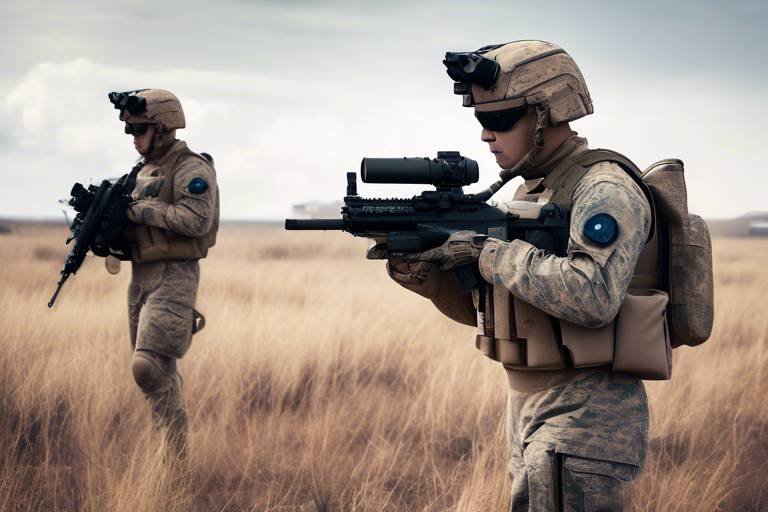The Future of Military Operations in Cyber Warfare
As we stand on the brink of a new era, the future of military operations in cyber warfare is not just a topic of discussion; it's a pressing reality that demands our attention. With the rapid evolution of technology and the increasing sophistication of cyber threats, military organizations around the globe are forced to adapt to a landscape that is constantly shifting beneath their feet. Imagine a battlefield where the enemy is not just a physical presence but a ghostly figure lurking within the digital realm, capable of striking at any moment. This is the new normal, and understanding it is crucial for national security and international relations.
Cyber warfare has evolved dramatically over the past few decades, transitioning from simple hacking incidents to complex operations involving state-sponsored actors and advanced technologies. Key milestones have marked this evolution, such as the infamous Stuxnet attack, which demonstrated how cyber tools could be used to disrupt critical infrastructure. As we delve deeper into this topic, we will explore the emerging technologies, strategies, and implications that define the future of military operations in cyber warfare.
Understanding how cyber warfare has developed over the years is crucial. The landscape of threats faced by military organizations globally has changed significantly, marked by a shift from traditional kinetic warfare to a more nuanced approach that incorporates cyber capabilities. Technological advancements have played a pivotal role in this transformation, enabling both offensive and defensive operations that were previously unimaginable. From the early days of hacking to the sophisticated cyber espionage tactics employed by nations today, the evolution of cyber warfare is a testament to the relentless pace of technological progress.
At the heart of this transformation are several key technologies that are reshaping military operations. Among them, artificial intelligence and machine learning stand out as game-changers. These technologies enhance the ability of military forces to detect, respond to, and even predict cyber threats. For instance, advanced encryption methods are being developed to secure sensitive data, while AI algorithms are deployed to analyze vast amounts of data for potential vulnerabilities. The impact of these technologies on cyber defense strategies cannot be overstated, as they provide military organizations with the tools needed to stay one step ahead of adversaries.
Artificial intelligence is revolutionizing cyber warfare by enhancing threat detection and response capabilities. Imagine having a digital sentinel that never sleeps, constantly scanning for anomalies and potential threats. This is precisely what AI brings to the table. Military operations are increasingly deploying AI algorithms to predict and counter cyber threats effectively. With the ability to learn from past incidents and adapt to new tactics, AI systems are becoming indispensable in modern warfare.
AI systems are increasingly used for real-time threat detection. These systems analyze vast data sets to identify anomalies and potential cyber attacks before they occur. By leveraging machine learning algorithms, military organizations can sift through mountains of data, pinpointing unusual patterns that may indicate an impending threat. This proactive approach not only enhances security but also allows for faster response times, crucial in the fast-paced world of cyber warfare.
Offensive cyber operations leverage AI for strategic advantages. Military forces are utilizing AI to develop sophisticated attack methods that can disrupt enemy communications and infrastructure. This capability allows for precision strikes in the digital domain, potentially crippling an adversary's operations without a single shot being fired. The implications of this shift are profound, as it blurs the lines between traditional warfare and cyber conflict.
As cyber threats grow, military organizations must adapt their defense strategies. This means moving beyond reactive measures to adopt proactive approaches like threat hunting and incident response. By actively seeking out potential vulnerabilities and addressing them before they can be exploited, military forces can safeguard critical systems from cyber attacks. The importance of a robust cyber defense strategy cannot be overstated, as the consequences of a breach can be catastrophic.
In an interconnected world, collaboration among nations is essential in addressing cyber threats. No single country can tackle these challenges alone; it requires a concerted effort. Alliances, information sharing, and joint exercises are vital in strengthening global cyber defense capabilities. The collective knowledge and resources shared among allied nations can significantly enhance their ability to respond to cyber threats effectively.
Joint initiatives among allied nations enhance collective cybersecurity. Countries are recognizing the need to work together to combat shared cyber threats effectively. Successful collaborations, such as NATO's Cyber Defense Policy, highlight the importance of unity in the face of common challenges. By pooling resources and expertise, nations can create a formidable defense against cyber adversaries.
The evolution of cyber warfare raises significant legal and ethical questions. Establishing international laws and norms governing state-sponsored cyber activities is a daunting task. The implications for warfare are profound, as the rules of engagement in the cyber realm are still being defined. Addressing these challenges is essential to ensure that military operations in cyberspace adhere to principles of justice and accountability.
- What is cyber warfare? Cyber warfare refers to the use of digital attacks by one nation to disrupt the vital computer systems of another, often targeting critical infrastructure.
- How has technology changed cyber warfare? Advancements in AI, machine learning, and encryption have transformed both offensive and defensive strategies in cyber warfare.
- Why is international collaboration important in cyber warfare? Cyber threats are global in nature, and collaboration allows nations to share intelligence, resources, and strategies to combat these threats effectively.
- What are the ethical implications of cyber warfare? The rise of cyber warfare raises questions about accountability, the rules of engagement, and the impact on civilian infrastructure.

The Evolution of Cyber Warfare
This article explores the evolving landscape of military operations in cyber warfare, examining emerging technologies, strategies, and the implications for national security and international relations.
The journey of cyber warfare is a fascinating tale that reflects our rapidly changing world. It all began in the late 20th century when the internet started to take shape. Initially, cyber operations were rudimentary, often limited to simple hacking attempts and basic malware. However, as technology advanced, so did the sophistication of cyber attacks. By the early 2000s, military organizations began to recognize the potential of cyber capabilities, leading to the establishment of dedicated cyber units.
One of the pivotal moments in the evolution of cyber warfare came during the 2007 cyber attack on Estonia. This incident served as a wake-up call for nations worldwide, highlighting how vulnerable critical infrastructure could be to cyber threats. The attack was a coordinated effort that disrupted government, banking, and media services, demonstrating the potential for cyber warfare to inflict real-world damage without a single shot being fired. This event marked a turning point, prompting nations to rethink their national security strategies.
As we moved into the 2010s, the landscape continued to evolve with the emergence of state-sponsored cyber attacks. Countries like Russia, China, and North Korea became infamous for their aggressive cyber operations. These nations employed advanced techniques, including phishing, DDoS attacks, and ransomware, to achieve political and economic objectives. Notably, the 2016 U.S. presidential election interference showcased the power of cyber warfare in shaping political outcomes, further emphasizing the need for robust cyber defenses.
Technological advancements have played a crucial role in this evolution. The rise of cloud computing, IoT devices, and big data analytics has opened new avenues for both attackers and defenders. For instance, the proliferation of connected devices has expanded the attack surface, making it easier for malicious actors to exploit vulnerabilities. On the other hand, these technologies also provide opportunities for military organizations to enhance their cyber capabilities.
Moreover, the integration of artificial intelligence and machine learning into cyber operations is revolutionizing the battlefield. AI algorithms can analyze massive datasets in real-time, allowing military units to detect anomalies and respond to threats more swiftly than ever before. This technological shift is not just about defense; it also enables offensive operations that can disrupt enemy communications and infrastructure.
In summary, the evolution of cyber warfare has transformed how nations approach military operations. From its humble beginnings to the sophisticated cyber strategies of today, the landscape continues to change at a breakneck pace. As threats become more complex and intertwined with global politics, understanding this evolution is crucial for policymakers and military leaders alike. The future of warfare is not just on land or sea; it now extends into the digital realm, where battles are fought in code and data.
- What is cyber warfare? Cyber warfare refers to the use of digital attacks by one nation to disrupt the vital computer systems of another, often to gain a strategic advantage.
- How has cyber warfare evolved? It has evolved from simple hacking to sophisticated state-sponsored attacks that can influence political outcomes and disrupt critical infrastructure.
- What technologies are shaping cyber warfare? Key technologies include artificial intelligence, machine learning, cloud computing, and the Internet of Things (IoT).
- Why is international collaboration important in cyber warfare? Collaboration among nations enhances collective cybersecurity and helps combat shared cyber threats effectively.

Key Technologies Shaping Cyber Warfare
In the rapidly evolving world of cyber warfare, technology plays a pivotal role in redefining how military operations are conducted. As we delve into the key technologies shaping this landscape, we can’t overlook the profound impact of artificial intelligence (AI), machine learning, and advanced encryption. These innovations are not just buzzwords; they are the backbone of modern military strategies aimed at enhancing both offensive and defensive capabilities in cyberspace.
One of the most significant advancements has been the integration of artificial intelligence into military operations. AI systems are being utilized to analyze massive datasets at lightning speed, allowing military organizations to detect potential threats and respond proactively. Imagine a digital sentinel that never sleeps, constantly monitoring for anomalies that could indicate a cyber attack. This capability is crucial, especially given the increasing frequency and sophistication of cyber threats. The military can leverage AI to not only identify threats but also to predict them, creating a formidable defense mechanism.
Furthermore, machine learning, a subset of AI, enhances these capabilities by allowing systems to learn from past data and improve their threat detection algorithms over time. For instance, by analyzing patterns from previous cyber incidents, machine learning models can identify new attack vectors that may not be immediately apparent to human analysts. This adaptive learning process is akin to teaching a soldier to anticipate enemy moves based on past encounters, making military operations more resilient and agile in the face of evolving threats.
Another critical technology is advanced encryption. As military communications and data transfer increasingly move online, the need for secure channels has never been more pressing. Advanced encryption technologies protect sensitive information from prying eyes, ensuring that only authorized personnel can access critical data. The ongoing development of quantum encryption promises to revolutionize this space further, offering potentially unbreakable security that could safeguard military operations from even the most sophisticated adversaries.
To illustrate the importance of these technologies, let’s consider a hypothetical scenario: A military base is under threat from a cyber attack aimed at disabling its communication systems. With AI-driven threat detection, the base’s cybersecurity team can identify the attack in real-time, thanks to machine learning algorithms that recognize unusual patterns of behavior. Meanwhile, advanced encryption protects the internal communications, ensuring that vital information remains secure and that the response team can coordinate effectively without interference from the attackers.
Moreover, these technologies are not operating in isolation. They are interlinked, creating a comprehensive defense strategy that enhances situational awareness and operational effectiveness. For example, AI can optimize encryption protocols, ensuring that data is not only secure but also transmitted efficiently. This synergy between technologies is crucial for military organizations that must stay one step ahead of adversaries.
As we look to the future, it is clear that the integration of these key technologies will continue to shape the battlefield of cyber warfare. The military's ability to adapt and innovate in this space will determine the effectiveness of its operations and, ultimately, its national security. The stakes are high, and the race for technological superiority in cyberspace is more competitive than ever.
- What role does AI play in cyber warfare? AI enhances threat detection and response capabilities, allowing military organizations to predict and counter cyber threats effectively.
- How does machine learning improve cybersecurity? Machine learning analyzes vast datasets to identify patterns and anomalies, helping to detect potential threats before they occur.
- Why is encryption important in military operations? Advanced encryption secures sensitive communications and data, protecting military operations from cyber espionage and attacks.
- What is the future of technology in cyber warfare? The future will likely see further advancements in AI, machine learning, and encryption, leading to more sophisticated and resilient military operations.

The Role of Artificial Intelligence
Artificial Intelligence (AI) is not just a buzzword; it's a game-changer in the realm of cyber warfare. Imagine having a digital assistant that not only helps you organize your schedule but also predicts potential cyber threats before they even materialize. This is the power of AI in military operations, where it enhances threat detection and response capabilities like never before. With the ability to analyze vast amounts of data in real time, AI systems are becoming essential tools for military organizations striving to stay one step ahead of adversaries.
One of the most exciting aspects of AI in cyber warfare is its capacity for predictive analytics. By utilizing machine learning algorithms, military forces can sift through enormous datasets to identify patterns and anomalies that might indicate an impending cyber attack. This proactive approach not only helps in early detection but also allows for a quicker response, which can be the difference between thwarting an attack and suffering significant damage.
But the role of AI doesn't stop at defense; it extends into the realm of offensive operations as well. Picture a military operation where AI algorithms are employed to devise sophisticated cyber attacks. These algorithms can analyze an enemy's digital infrastructure, identify vulnerabilities, and execute attacks with precision. Such capabilities can disrupt enemy communications and cripple critical infrastructure, providing a strategic edge in conflict scenarios. This duality of AI—enhancing both defensive and offensive capabilities—illustrates its transformative potential in modern warfare.
Moreover, AI's ability to learn and adapt means that it can continuously improve its tactics and strategies based on past experiences. This self-evolving nature is akin to a soldier who learns from each battle, becoming more effective with each encounter. As military organizations increasingly incorporate AI into their operations, they are not just investing in technology; they are investing in a future where cyber warfare is fought with unparalleled efficiency and effectiveness.
However, the integration of AI into military operations does not come without challenges. Ethical considerations arise when machines make decisions that could lead to significant consequences. Questions about accountability and the potential for unintended escalation in conflicts must be addressed. As we forge ahead into this new era of warfare, it's crucial to strike a balance between leveraging AI's capabilities and ensuring that human oversight remains at the forefront of military strategy.
- What is the primary benefit of AI in cyber warfare?
The primary benefit of AI in cyber warfare is its ability to enhance threat detection and response capabilities, allowing military organizations to identify and mitigate cyber threats more effectively.
- How does AI improve offensive cyber operations?
AI improves offensive cyber operations by analyzing enemy infrastructure and developing sophisticated attack strategies that can exploit vulnerabilities and disrupt communications.
- What are the ethical concerns surrounding AI in military operations?
Ethical concerns include questions of accountability, the potential for unintended consequences, and the need for human oversight in decision-making processes.

AI in Threat Detection
In the world of cyber warfare, the stakes are incredibly high, and the need for rapid, effective threat detection has never been more critical. Enter Artificial Intelligence (AI). This technology is not just a buzzword; it is a game-changer that is reshaping how military organizations detect and respond to cyber threats. Imagine having a digital watchdog that never sleeps, tirelessly analyzing data streams and identifying potential threats before they even manifest. That's the power of AI in threat detection.
AI systems are designed to process vast amounts of data at lightning speed, far beyond human capability. They utilize machine learning algorithms that continuously learn from new data, improving their accuracy over time. For instance, when an AI system analyzes network traffic, it can identify patterns and anomalies that may indicate a cyber attack. This capability is crucial because, in many cases, traditional methods of threat detection can be too slow or ineffective in recognizing sophisticated attacks.
To illustrate how AI enhances threat detection, consider the following key functions:
- Real-Time Analysis: AI can monitor network traffic in real-time, flagging unusual activity as it happens. This immediacy allows military cybersecurity teams to respond swiftly, potentially thwarting an attack before it escalates.
- Anomaly Detection: By establishing a baseline of normal behavior, AI systems can quickly identify deviations that may suggest an intrusion or attack. Think of it as having a security system that knows when something feels "off" in your home.
- Predictive Capabilities: Advanced AI models can predict future threats based on historical data, enabling proactive measures to be taken before an attack occurs. It's like having a crystal ball that reveals potential dangers lurking on the horizon.
Moreover, AI's ability to adapt and evolve means that it can stay ahead of cybercriminals who are constantly developing new techniques. Traditional defense mechanisms often rely on known signatures of attacks, but AI can recognize new, previously unseen threats by analyzing behaviors rather than just signatures. This is akin to teaching a dog to recognize not just the sound of a doorbell but also the footsteps of someone approaching the house.
However, while AI presents incredible advantages, it is not without challenges. The reliance on AI for threat detection raises questions about the potential for false positives—instances where benign activity is mistakenly flagged as a threat. This can lead to unnecessary alarm and resource allocation, which can be counterproductive in a military context where every second counts. Therefore, it is essential to continuously refine AI systems and integrate human oversight to ensure accuracy and reliability.
In conclusion, the integration of AI in threat detection is revolutionizing military operations in cyber warfare. By leveraging advanced algorithms and real-time data analysis, military organizations can enhance their ability to detect and respond to cyber threats effectively. As technology continues to evolve, the collaboration between AI systems and human analysts will be crucial in staying one step ahead of adversaries in this ever-changing landscape.
- What is AI in threat detection? AI in threat detection refers to the use of artificial intelligence technologies to identify and respond to cyber threats in real-time.
- How does AI improve threat detection? AI improves threat detection by analyzing large data sets quickly, identifying anomalies, and predicting potential attacks based on past behavior.
- Are there any challenges associated with AI in threat detection? Yes, challenges include the risk of false positives and the need for human oversight to ensure accuracy and reliability.
- Can AI predict future cyber threats? Yes, advanced AI models can analyze historical data to predict future threats, allowing for proactive defense measures.

AI in Offensive Cyber Operations
In the fast-paced world of military operations, artificial intelligence (AI) is not just a buzzword; it's a game changer, especially when it comes to offensive cyber operations. Imagine a battlefield where decisions are made in milliseconds, where algorithms can predict enemy movements, and where attacks can be launched with pinpoint accuracy. This is not science fiction; it's the reality that AI is bringing to the forefront of cyber warfare. By leveraging advanced AI technologies, military forces are developing sophisticated attack methods that can disrupt enemy communications and infrastructure, fundamentally altering the landscape of warfare.
One of the most compelling aspects of AI in offensive operations is its ability to analyze vast amounts of data in real-time. Think of it as having a super-intelligent assistant that can sift through terabytes of information, identifying patterns and anomalies that a human analyst might miss. This capability allows military strategists to anticipate potential threats and develop countermeasures before an attack even occurs. Furthermore, AI can automate many of the tedious tasks associated with cyber operations, freeing up human operators to focus on more complex decision-making processes.
The integration of AI into offensive cyber strategies also enhances the effectiveness of cyber attacks. For instance, AI can be used to create adaptive malware that learns from its environment and adjusts its tactics accordingly. This means that once an attack is initiated, the malware can change its behavior based on the defensive measures it encounters, making it much harder to detect and neutralize. Additionally, AI can optimize the timing and delivery of attacks, ensuring that they strike when the target is most vulnerable.
Moreover, the use of AI in offensive operations raises critical questions about ethics and accountability. As military organizations increasingly rely on autonomous systems to conduct cyber attacks, the line between human and machine decision-making becomes blurred. Who is responsible when an AI-driven attack goes awry? These are the types of questions that military leaders and policymakers must grapple with as they navigate the evolving landscape of cyber warfare.
To illustrate the potential of AI in offensive cyber operations, consider the following table, which outlines various applications of AI technologies and their implications for military strategy:
| AI Application | Description | Implications for Military Strategy |
|---|---|---|
| Adaptive Malware | Malware that learns and evolves based on its environment. | Increased difficulty in detection and neutralization. |
| Automated Decision-Making | AI systems that can make real-time decisions without human input. | Faster response times and reduced cognitive load on operators. |
| Predictive Analytics | Using historical data to forecast enemy actions. | Enhanced situational awareness and proactive strategies. |
In conclusion, the role of AI in offensive cyber operations is transforming how military organizations approach warfare. As these technologies continue to evolve, they promise to deliver unprecedented capabilities for disruption and defense. However, with great power comes great responsibility, and it is crucial for military leaders to consider the ethical implications of their decisions in this new digital age. The battlefield of the future will not only require technological prowess but also a thoughtful approach to the moral dilemmas posed by AI-driven warfare.
- What is AI in cyber warfare?
AI in cyber warfare refers to the use of artificial intelligence technologies to enhance military operations, particularly in offensive and defensive cyber strategies.
- How does AI improve offensive cyber operations?
AI improves offensive operations by enabling real-time data analysis, automating tasks, and developing adaptive malware that can evade detection.
- What are the ethical concerns surrounding AI in military operations?
Ethical concerns include accountability for AI-driven actions, the potential for unintended consequences, and the moral implications of autonomous warfare.
- Can AI predict enemy actions?
Yes, AI can analyze historical data to forecast enemy movements and strategies, enhancing situational awareness for military planners.

Cyber Defense Strategies
As the landscape of cyber warfare continues to evolve, military organizations must be proactive in developing robust to safeguard their critical systems. The stakes are higher than ever; with sophisticated cyber threats emerging daily, traditional defense mechanisms often fall short. It's akin to trying to protect a castle with a crumbling wall—eventually, the invaders will find a way in. Hence, a multi-faceted approach is essential for effective cyber defense.
One of the primary strategies involves threat hunting. This proactive measure focuses on identifying vulnerabilities before they can be exploited. By continuously monitoring networks and systems for unusual activity, military organizations can detect potential threats early on. This is not just about reacting to known threats but actively seeking out the unknown. Imagine a detective on the hunt for clues, piecing together evidence to prevent a crime before it happens.
Another critical component of cyber defense is the incident response plan. When a cyber attack does occur, having a well-defined response strategy can mean the difference between a minor inconvenience and a catastrophic breach. This involves not just fixing the immediate problem but also understanding how the breach occurred and taking steps to prevent it from happening again. Think of it as a fire drill; you prepare for the worst-case scenario so that when disaster strikes, you're ready to act swiftly and efficiently.
Moreover, the integration of advanced technologies such as artificial intelligence and machine learning is reshaping how military organizations approach cyber defense. These technologies can analyze vast amounts of data in real-time, identifying patterns and anomalies that human operators might miss. For instance, AI can help in monitoring network traffic to flag unusual behaviors that could indicate a cyber attack in progress. This capability is akin to having a highly trained guard dog that never sleeps, always on alert for any signs of trouble.
Furthermore, military organizations are increasingly focusing on collaboration and information sharing with other nations and private sectors. Cyber threats do not respect borders, and neither should defense strategies. By forming alliances and sharing intelligence, countries can bolster their defense mechanisms. This collective approach is similar to a neighborhood watch program, where everyone looks out for one another, pooling resources and knowledge to enhance overall security.
In summary, as cyber threats become more sophisticated, military organizations must adapt their defense strategies accordingly. This involves a combination of proactive measures like threat hunting, well-defined incident response plans, leveraging advanced technologies, and fostering international collaboration. Just like in any battle, the key to winning is to stay one step ahead of the enemy.
- What is threat hunting? Threat hunting is a proactive cybersecurity practice that involves actively searching for signs of malicious activities within a network rather than relying solely on automated alerts.
- Why is incident response important? Incident response is crucial because it helps organizations quickly address and mitigate the impact of a cyber attack, minimizing potential damage and recovery time.
- How does AI enhance cyber defense? AI enhances cyber defense by analyzing vast data sets to identify patterns and anomalies, enabling faster detection of potential threats and automating responses.
- Why is international collaboration necessary in cyber defense? Cyber threats are global in nature, and collaboration allows nations to share intelligence, resources, and strategies, making collective defense more effective.

International Collaboration in Cyber Warfare
In today's interconnected world, the notion of national security has evolved dramatically, especially in the realm of cyber warfare. Cyber threats don't respect borders; they can originate from anywhere and affect nations indiscriminately. Therefore, international collaboration has become not just beneficial but essential in combating these threats. Countries are beginning to recognize that a unified front is necessary to tackle the complexities of cyber warfare, which often involves state-sponsored actors, criminal organizations, and even rogue individuals.
One of the key aspects of this collaboration is the sharing of intelligence and resources. Nations are increasingly engaging in partnerships that allow them to exchange vital information about emerging threats and vulnerabilities. This sharing can take many forms, from formal alliances like NATO to informal networks of cybersecurity experts who collaborate across borders. For instance, when a country detects a new malware strain, sharing this information can help others bolster their defenses before they even become targets.
Moreover, joint exercises and training programs are becoming commonplace. These initiatives not only enhance the technical skills of military and cybersecurity personnel but also foster trust and understanding among allied nations. By simulating cyber attacks and practicing coordinated responses, countries can improve their readiness and adaptability in real-world scenarios. A prime example of this is the annual Cyber Coalition exercise, where NATO and partner nations come together to test their defenses against cyber threats.
However, international collaboration in cyber warfare is not without its challenges. Different countries have varying levels of technological advancement, legal frameworks, and ethical standards, which can complicate joint efforts. For instance, what one nation considers a legitimate defensive measure might be viewed as an act of aggression by another. This discrepancy underscores the importance of establishing international norms and agreements that govern state behavior in cyberspace.
To illustrate the growing importance of international collaboration, consider the following table that outlines some of the key initiatives and partnerships currently in place:
| Initiative | Description | Participating Countries |
|---|---|---|
| NATO Cooperative Cyber Defence Centre of Excellence | A research and training facility focusing on enhancing NATO's cyber defense capabilities. | NATO Member States |
| EU Cybersecurity Strategy | A framework for enhancing cybersecurity across European Union member states. | EU Member States |
| Five Eyes Alliance | An intelligence alliance comprising Australia, Canada, New Zealand, the UK, and the US. | Five Eyes Nations |
As the landscape of cyber warfare continues to evolve, the importance of international collaboration cannot be overstated. Countries must work together, share knowledge, and develop common strategies to effectively combat the threats posed by cyber adversaries. In this digital age, the phrase “united we stand, divided we fall” rings truer than ever, especially when it comes to safeguarding national security in cyberspace.
- Why is international collaboration important in cyber warfare? - Cyber threats are global in nature and require a coordinated response to effectively mitigate risks.
- What are some examples of international initiatives? - Initiatives like NATO's Cyber Defence Centre and the EU Cybersecurity Strategy highlight collaborative efforts among nations.
- How do countries share information about cyber threats? - Nations engage in formal and informal networks to exchange intelligence and best practices for cyber defense.
- What challenges exist in international cyber collaboration? - Differences in legal frameworks, technological capabilities, and ethical standards can complicate cooperative efforts.

Joint Cyber Defense Initiatives
In today's interconnected world, the threat landscape of cyber warfare has evolved dramatically, making more crucial than ever. Countries are beginning to realize that cyber threats do not respect borders; they can strike at any time, anywhere. This understanding has led to the formation of collaborative frameworks aimed at enhancing collective cybersecurity. The essence of these initiatives lies in the principle that by working together, nations can share resources, knowledge, and strategies to effectively counteract cyber threats that may arise from state-sponsored attacks or malicious non-state actors.
One of the most significant examples of joint cyber defense initiatives is the establishment of the NATO Cooperative Cyber Defence Centre of Excellence in Estonia. This center serves as a hub for research, training, and cooperation among member nations. It focuses on improving the technical capabilities of allied forces and developing best practices for cyber defense. The collaborative efforts at this center have proven invaluable, as they allow members to learn from each other's experiences and strengthen their defenses against common threats.
Another noteworthy initiative is the Five Eyes alliance, which includes Australia, Canada, New Zealand, the United Kingdom, and the United States. This intelligence-sharing partnership has expanded its focus to include cyber threats, facilitating the exchange of critical information regarding vulnerabilities and emerging threats. By pooling their intelligence resources, these nations can respond more effectively to cyber incidents and mitigate potential risks.
Moreover, the European Union has also taken significant steps towards enhancing collective cybersecurity through initiatives like the EU Cybersecurity Strategy. This strategy emphasizes the importance of collaboration among member states and encourages the development of a robust cybersecurity framework that includes joint exercises, information sharing, and coordinated responses to cyber incidents. Such initiatives not only bolster national security but also promote a culture of resilience across the region.
However, while these joint initiatives are promising, they also face challenges. One of the primary hurdles is the disparity in cybersecurity capabilities among nations. Some countries possess advanced technological resources, while others struggle with basic cybersecurity measures. This gap can create vulnerabilities that adversaries may exploit. Therefore, it is essential to establish mechanisms for capacity building, ensuring that all participating nations can contribute effectively to joint efforts.
In conclusion, joint cyber defense initiatives represent a proactive approach to tackling the complexities of cyber warfare. By fostering collaboration, sharing intelligence, and developing unified strategies, nations can enhance their resilience against cyber threats. As the digital battlefield continues to evolve, these initiatives will play a pivotal role in safeguarding national interests and ensuring global security.
- What are joint cyber defense initiatives?
Joint cyber defense initiatives are collaborative efforts among nations to enhance their collective cybersecurity capabilities, share intelligence, and develop coordinated strategies to combat cyber threats. - Why are joint initiatives important?
These initiatives are crucial because cyber threats often cross borders, and a coordinated response can be more effective than isolated national efforts. - What challenges do joint cyber defense initiatives face?
Challenges include disparities in cybersecurity capabilities among nations, which can create vulnerabilities, as well as legal and political hurdles in information sharing. - Can you give an example of a successful joint initiative?
Yes, the NATO Cooperative Cyber Defence Centre of Excellence in Estonia is a prominent example of a successful joint initiative that focuses on enhancing member nations' cybersecurity capabilities.

Legal and Ethical Considerations
The evolution of cyber warfare has ushered in a plethora of legal and ethical challenges that nations must grapple with. As military operations increasingly rely on cyber capabilities, the question arises: how do we govern actions that can occur in milliseconds across the globe? The traditional laws of warfare, which were designed for physical battles, often fall short in addressing the complexities of the digital battlefield. For instance, what constitutes an act of war in cyberspace? Is a cyber attack that disrupts a nation's critical infrastructure equivalent to a physical assault? These questions are not just academic; they have real-world implications for national security and international relations.
One of the primary legal challenges is the lack of a comprehensive international framework governing state-sponsored cyber activities. Unlike conventional warfare, where treaties such as the Geneva Conventions provide guidelines, the rules of engagement in cyber warfare remain murky. This ambiguity can lead to escalations, misunderstandings, and even unintended conflicts. For example, a cyber operation that one nation views as a defensive measure could be perceived by another as an act of aggression. This misinterpretation could spiral into a larger conflict, highlighting the urgent need for clear international norms and agreements.
Moreover, ethical considerations play a crucial role in shaping how nations approach cyber warfare. The potential for collateral damage in cyberspace is significant. A cyber attack aimed at military installations may inadvertently affect civilian infrastructure, leading to unintended consequences. This raises critical ethical questions: Should military forces prioritize operational success over civilian safety? How can they ensure that their actions do not violate the principles of proportionality and distinction, which are cornerstones of international humanitarian law?
To navigate these challenges, nations must engage in dialogue and collaboration to establish shared norms and legal frameworks. Initiatives such as the Budapest Convention on Cybercrime aim to foster international cooperation, but more comprehensive agreements are necessary to address the unique aspects of cyber warfare. Additionally, countries need to invest in developing robust cyber defense strategies that not only protect their own interests but also respect the sovereignty and rights of other nations.
In conclusion, as we continue to witness the rise of cyber warfare, it is imperative for military organizations and governments to address the that accompany these new forms of conflict. Establishing clear guidelines and fostering international cooperation will be essential in preventing misunderstandings and ensuring that the digital battlefield does not become a catalyst for widespread chaos and destruction.
- What are the main legal challenges in cyber warfare? Legal challenges include the lack of international agreements governing state-sponsored cyber activities and the ambiguity surrounding what constitutes an act of war in cyberspace.
- How do ethical considerations impact cyber warfare? Ethical considerations impact decisions regarding civilian safety, the potential for collateral damage, and adherence to principles of proportionality and distinction in military operations.
- What steps can nations take to address these challenges? Nations can engage in dialogue to establish shared norms, invest in international cooperation initiatives, and develop robust cyber defense strategies that respect the rights of other nations.
Frequently Asked Questions
- What is cyber warfare?
Cyber warfare refers to the use of digital attacks by one nation to disrupt the vital computer systems of another, often to achieve strategic military objectives. It involves a range of activities, including hacking, espionage, and the deployment of malware to damage or disable critical infrastructure.
- How has cyber warfare evolved over the years?
The evolution of cyber warfare has been marked by significant technological advancements and an increase in the sophistication of attacks. Initially, cyber warfare was primarily focused on espionage and information theft. However, it has now expanded to include disruptive attacks on critical infrastructure, such as power grids and communication networks, making it a vital component of modern military strategy.
- What role does artificial intelligence play in cyber warfare?
Artificial intelligence (AI) is transforming cyber warfare by enhancing both offensive and defensive capabilities. AI algorithms can analyze vast amounts of data to detect anomalies and predict potential threats, allowing military organizations to respond more effectively to cyber attacks. Additionally, AI can be used to develop sophisticated offensive strategies that target enemy systems.
- What are the key technologies shaping cyber warfare?
Key technologies shaping cyber warfare include artificial intelligence, machine learning, advanced encryption techniques, and blockchain technology. These innovations are crucial for improving threat detection, enhancing data security, and enabling more effective military operations in the cyber domain.
- Why is international collaboration important in cyber warfare?
International collaboration is essential in cyber warfare because cyber threats often transcend national borders. By sharing information, resources, and best practices, countries can strengthen their collective defense capabilities and respond more effectively to shared threats. Joint exercises and initiatives also foster trust and improve coordination among allied nations.
- What are the legal and ethical considerations in cyber warfare?
The legal and ethical considerations in cyber warfare include the establishment of international laws governing state-sponsored cyber activities, the protection of civilian infrastructure, and the potential for collateral damage. As the landscape of warfare changes, developing clear norms and guidelines is crucial to ensure accountability and minimize harm.
- How do military organizations adapt their cyber defense strategies?
Military organizations adapt their cyber defense strategies by implementing proactive measures such as threat hunting, incident response, and continuous monitoring of networks. They also invest in advanced technologies and training to ensure their personnel are equipped to deal with the evolving threat landscape.



















